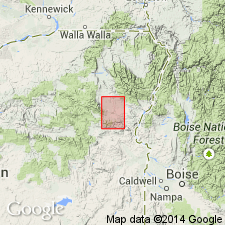
- Usage in publication:
-
- Clover Creek greenstone*
- Modifications:
-
- Original reference
- Dominant lithology:
-
- Volcanics
- Limestone
- Chert
- AAPG geologic province:
-
- Snake River basin
Summary:
Clover Creek greenstone. Altered volcanic flows and pyroclastic rocks, with subordinate limestone and chert. [The volcanic rocks consist of chloritized and locally silicified and sheared keratophyre, quartz keratophyre, and very minor spilite.] Thickness 4,000 feet. Unconformably underlies pre-Miocene gravels. Relation to Elkhorn Ridge argillite (Pennsylvanian?) unknown. [Provisionally assigned age of Permian, based on fossils (brachiopod productids) found 6 mi northwest of type locality].
[Type locality]: exposures along Clover Creek, in secs. 24, 25, 26, and 35, T. 7 S., R. 42 E., Baker quadrangle, northeastern OR. Named from Clover Creek.
Source: US geologic names lexicon (USGS Bull. 896, p. 470; supplemental information (in brackets) excerpted from Beaulieu (1972, Oregon Dept. Geol. and Min. Ind. Bull., no. 73, p. 10-12).
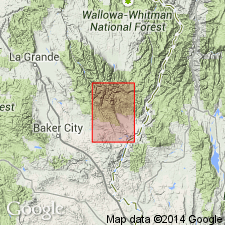
- Usage in publication:
-
- Clover Creek greenstone
- Modifications:
-
- Revised
- AAPG geologic province:
-
- Snake River basin
Summary:
Author found strata characteristic of the Clover Creek greenstone of Gilluly (1937) to be widely exposed in the southeastern part of the Wallowa Mountains. He mapped sequences consisting mostly of andesitic and dacitic volcanic rocks as part of the Clover Creek greenstone; however, the predominantly sedimentary sequences were called "Carboniferous(?) sedimentary rocks." The close, partly equivalent, relationship of these two units was noted.
Source: Excerpted from Beaulieu (1972, Oregon Dept. Geol. and Min. Ind. Bull., no. 73, p. 10-12).
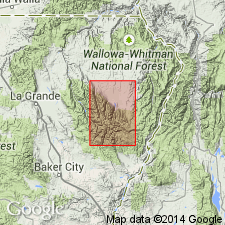
- Usage in publication:
-
- Clover Creek greenstone*
- Modifications:
-
- Overview
- AAPG geologic province:
-
- Snake River basin
Summary:
Pg. 6 (fig. 2), 7-8. Clover Creek greenstone. Described in Wallowa Lake quadrangle, northeastern Oregon, where it is 3,000 to 5,000 feet thick. Base not observed. Conformably underlies a unit termed "Lower Sedimentary Series," or where series is lacking unconformably underlies Martin Bridge formation. Age is Permian.
The "Lower Sedimentary Series" contains Late Triassic fossils and, because of lithologic similarity, includes most of Ross' (1938) "Carboniferous(?) sedimentary rocks."
Source: US geologic names lexicon (USGS Bull. 1200, p. 847-848); supplemental information excerpted from Beaulieu (1972, Oregon Dept. Geol. and Min. Ind. Bull., no. 73, p. 10-12).
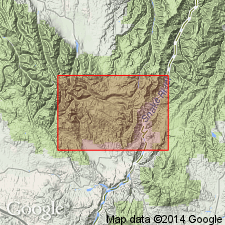
- Usage in publication:
-
- Clover Creek Greenstone
- Modifications:
-
- Areal extent
- AAPG geologic province:
-
- Snake River basin
Summary:
In parts of Cornucopia and Eagle Cap quadrangles, rocks assigned to the Clover Creek Greenstone and "Lower Sedimentary Series" by Smith and Allen (1941) are reallocated to newly informally named "Imnaha Formation" (Upper Triassic) and "Trinity Creek Formation" (Permian), based on fossils and lithology.
Source: Excerpted from Beaulieu (1972, Oregon Dept. Geol. and Min. Ind. Bull., no. 73, p. 10-12).

- Usage in publication:
-
- Clover Creek Greenstone
- Modifications:
-
- Age modified
- Biostratigraphic dating
- AAPG geologic province:
-
- Snake River basin
Summary:
Authors report both Permian and Triassic fossils in rocks assigned to the Clover Creek Greenstone by Gilluly (1937). Fossil localities nearest the type locality yielded Late Triassic fossils. Exposures at the type locality are believed to be Late Triassic age.
Source: Excerpted from Beaulieu (1972, Oregon Dept. Geol. and Min. Ind. Bull., no. 73, p. 10-12); GNC index card files (USGS-Reston).
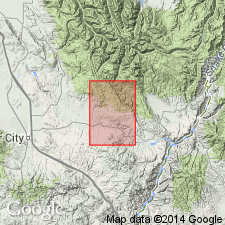
- Usage in publication:
-
- Clover Creek Greenstone
- Clover Creek Group
- Modifications:
-
- Mapped 1:62.5k
- Dominant lithology:
-
- Volcanics
- Sandstone
- AAPG geologic province:
-
- Snake River basin
Summary:
In the Sparta quadrangle, the formation consists of basaltic to rhyolitic volcanic flows, coarse- to fine-grained volcanic wackes, sandstones, tuff, and subordinate amounts of chert, conglomerate, and limestone. It is exposed along Balm Creek, Larkspur Creek, and Goose Creek, at the head of Red Gulch and in the canyons of Dempsey and Eagle Creeks. In the western part of the quadrangle the sediments tend to be fine-grained, and volcanic flows make up about half of the formation. Eastward, the sediments coarsen to wackes and conglomerates, and volcanic flows are less abundant. Spilites and keratophyres are the most common volcanic rocks. At the time of writing, the Clover Creek Greenstone was in the process of being elevated to group rank and subdivided into two new formations, the Harsin Ranch and the Tucker Creek Formations of Permian and Late Triassic ages respectively (Koch and Bowen, 1962, written commun.) [As of 2006, these revisions have not been published]. In the Sparta quadrangle, Clover Creek Greenstone rocks are believed to be Triassic age, based on Triassic fossils collected from limestone lenses in the greenstone at both the eastern and western borders of the quadrangle; they would be equivalent to the Tucker Creek Formation and may be referred to by that name.
Source: Publication.

- Usage in publication:
-
- Clover Creek Greenstone
- Modifications:
-
- Areal extent
- AAPG geologic province:
-
- Snake River basin
Summary:
In northwestern part of Sparta quadrangle, contiguous with the type locality, the Clover Creek Greenstone is divided into 5 informal vertically arranged conformable units. Clover Creek is described in detail. Consists of (in ascending order): fine-grained volcanic sandstone and keratophyre tuff underlain by coarse sandstone and breccia, 300 feet; spilite flows, 300 feet; keratophyre and quartz keratophyre flows, tuffs, and breccia, 1,000 feet; fine-grained volcaniclastic sediments, 1,900 feet; and spilite and meta-andesite, 400 feet. Rests depositionally upon granites interpreted to be Early Triassic. Report includes generalized composite section.
Recently, Prostka (1971, written commun.) interprets the uppermost unit (unit "A") to disconformably overlie the lower 4 units, and he correlates it with his "Gold Creek Greenstone" and "Lower Sedimentary Series" (both in the northeast part of the Sparta quadrangle) and the "Imnaha Formation" of Wetherell (1960). Vallier (1971, oral commun.), considers the "Imnaha Formation" and the "Gold Creek Greenstone" to be lateral equivalents of the Late Triassic part of the Clover Creek Greenstone of Gilluly (1937).
Source: Excerpted from Beaulieu (1972, Oregon Dept. Geol. and Min. Ind. Bull., no. 73, p. 10-12).

- Usage in publication:
-
- Clover Creek Greenstone
- Modifications:
-
- Areal extent
- AAPG geologic province:
-
- Snake River basin
Summary:
Remapped much of area previously mapped by Smith and Allen (1941) in the northern Wallowa Mountains. Divided Clover Creek Greenstone into 3 new [informal] members (descending): Mount Howard member, Chief Joseph member, and Dunn Creek conglomerate member. On Chief Joseph Mountain, the Chief Joseph and Dunn Creek members are approx. same as Smith and Allen's (1941) "Lower Sedimentary Series."
Source: Excerpted from Beaulieu (1972, Oregon Dept. Geol. and Min. Ind. Bull., no. 73, p. 10-12) citing Vallier (1967, p. 20).
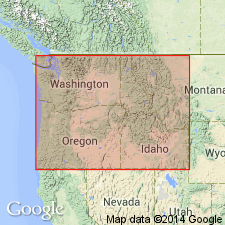
- Usage in publication:
-
- Clover Creek Greenstone
- Modifications:
-
- Areal extent
- AAPG geologic province:
-
- Eastern Columbia basin
- Idaho Mountains province
- Snake River basin
Summary:
Discovered Ladinian (late Middle Triassic) and Karnian (Late Triassic) age fossils in his "Grassy Ridge Formation," a unit which he equated with parts of the Clover Creek Greenstone and "Imnaha Formation." Permian strata in the Snake River Canyon, assigned to the "Hunsaker Creek Formation," are equivalent in part to the "Trinity Creek Formation" of Wetherell (1960) and possibly the Permian rocks included in the Clover Creek by Gilluly (1937) farther to the west.
Source: Excerpted from Beaulieu (1972, Oregon Dept. Geol. and Min. Ind. Bull., no. 73, p. 10-12).

- Usage in publication:
-
- Clover Creek Greenstone
- Modifications:
-
- Overview
- AAPG geologic province:
-
- Snake River basin
Summary:
Pg. 10-12. Author provides overview of nomenclature history and present (ca. 1971) state of knowledge [see excerpts under Gilluly, 1937; Ross, 1938; Smith and Allen, 1941; Wetherell, 1960; Bostwick and Koch, 1962; Prostka, 1963; Nolf, 1966; and Vallier, 1967 entries]. Poor exposures, marked facies variations (both laterally and vertically), the scarcity of fossils, and regional similarities in structural geometry and degree of metamorphism have made subdivision of the section extremely difficult. Gilluly (1937) suggested that the unit extended eastward from the type locality to the vicinity of Homestead. Thereafter a trend was established in which many greenstones of similar appearance in the Wallowa Mountains were assigned to the Clover Creek; a complexity of obscure correlations and stratigraphic interpretations has developed so that the nomenclature of the rocks is now highly confused.
Clover Creek Greenstone is part of a heterogeneous assemblage of metamorphosed volcanic and sedimentary rocks of Permian and Late Triassic age which underlies Martin Bridge Formation in the Wallowa Mountains and adjacent areas. Gilluly (1937) assigned a provisional Permian age to Clover Creek, based on brachiopod productids found 6 mi northwest of type locality. Recent discoveries of Late Triassic fossils, notably PENTACRINUS and HALOBIA, throughout much of the unit have established that a large part of the Clover Creek is Late Triassic in age. In view of the large time gap separating the fossils of Permian age from those of Late Triassic age, it is apparent that two distinct stratigraphic units are included in the Clover Creek Greenstone of Gilluly (1937).
Source: Publication.
For more information, please contact Nancy Stamm, Geologic Names Committee Secretary.
Asterisk (*) indicates published by U.S. Geological Survey authors.
"No current usage" (†) implies that a name has been abandoned or has fallen into disuse. Former usage and, if known, replacement name given in parentheses ( ).
Slash (/) indicates name conflicts with nomenclatural guidelines (CSN, 1933; ACSN, 1961, 1970; NACSN, 1983, 2005, 2021). May be explained within brackets ([ ]).

